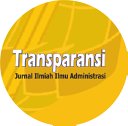Governance Networks Dalam Implementasi Kebijakan Pemanfaatan Data Kependudukan Guna Mewujudkan Single Identity Number
DOI:
https://doi.org/10.31334/transparansi.v5i1.2285Keywords:
Pemanfaatan data kependudukan, Single Identity Number, validasi, verifikasi,Abstract
Identitas berdasarkan Kamus Besar Bahasa Indonesia adalah ciri-ciri atau keadaan khusus yang disebut juga jati diri. Identitas tersebut menjadi cerminan diri dan juga penting sebagai pengakuan atas diri seseorang. Melalui sistem pencatatan sipil dalam administrasi kependudukan, negara menyetujui keabsahan identitas pribadi dan status hukum penduduk yang diatur dalam UU Adminduk, serta dituangkan dalam bentuk Nomor Induk Kependudukan (NIK) dan dokumen kependudukan. NIK dalam hal ini ditujukan untuk menjadi Single Identity Number Sebagaimana sifatnya melekat permanen pada seseorang untuk seumur hidup. Untuk itu, NIK juga merupakan kunci utama dalam verifikasi dan validasi identitas seseorang. Untuk mencapai kesepahaman terkait NIK sebagai single identity number, penting bagi Ditjen Dukcapil untuk membuat lembaga lain memercayai ketunggalan NIK sebagai identitas yang merepresentasikan setiap orang. Melalui proses verifikasi dan validasi identitas penduduk dalam pemberian layanan publik ini, data kependudukan yang dikumpulkan melalui perekaman KTP-el dan dokumen administrasi lainnya dapat dimanfaatkan untuk menuju single identity number, sekaligus memberikan dasar dalam integrasi administrasi. Ditjen Dukcapil dalam hal ini diposisikan sebagai katalisator dalam membentuk jaringan multiorganisasional melalui kebijakan pemanfaatan data kependudukan. Governance networks yang terjalin dalam implementasi kebijakan pemanfaatan data kependudukan bertujuan untuk membangun ekosistem single identity number, dimana ekosistem tersebut meliputi ekosistem di pemerintahan, ekosistem di swasta, ekosistem di perguruan tinggi, ekosistem di industri keuangan. Melalui pembangunan ekosistem dimana berbagai sektor terhubung dalam rangka verifikasi dan validasi identitas penduduk, pemanfaatan data menjadi pintu masuk bagaimana agar single identity number tersebut dapat terimplementasikan dengan baik. Di sisi lain, hubungan kemitraan atau kerja sama dengan pengguna juga memiliki resistensi yang cukup tinggi terhadap digunakannya NIK sebagai single identity number, dimana ego sektoral atau silo mentality masih cukup kuat. Selain itu, masih banyaknya pengguna yang belum menggunakan data Dukcapil, misalnya baru 10% lembaga pendidikan yang sudah melakukan kerja sama pemanfaatan data kependudukan. Selanjutnya, di sisi internal Ditjen Dukcapil, SOP yang mengatur kesinambungan antar subdit belum ada dan SOP yang mengatur sistem kerja di dalam subdit sudah tidak relevan. Kepatuhan pengguna terhadap pemenuhan kewajiban dalam kerja sama juga belum maksimal, serta kurang memadainya sumber daya untuk melakukan evaluasi dibandingkan dengan banyaknya pengguna, sehingga sulit dilakukan analisis terhadap evaluasi dan monitoring implementasi kebijakan pemanfaatan data kependudukan.References
Acquist, A. & Gross, R. 2009. Predicting Social Security numbers from public data. Proceedings of the National Academy of Sciences of the United States of America, 106 (27): 10975 – 10980.
Adèle, P. A. 2017. The social security number: A small device underpinning big systems. International Social Security Review, 70 (1): 3-17.
Arikunto, Suharsimi. 2006. Metode Penelitian Kuantitatif Kualitatif dan R&D. Bandung: CV Alfabeta.
Bhatia, Amiya. & Bhabha, Jacqueline. 2017. India’s Aadhaar scheme and the promise of inclusive social protection. Oxford Development Studies, 45 (1): 539 – 567.
Chaudhuri, B., & König, L. 2018. The Aadhaar scheme: a cornerstone of a new citizenship regime in India? Contemporary South Asia, 26 (2): 127-142.
Creswell, John W. 2003. Research Design Qualitative, Quantitative, and Mixed Methods Approach. London: Sage Publications.
Dijk, N. v., Tanas, A., Rommetveit, K., & Raab, C. (2018). Right engineering? the redesign of privacy and personal data protection.
International Review of Law, Computers & Technology, 32 (2-3): 230-256.
Kementerian Dalam Negeri Republik Indonesia. Peraturan Menteri Dalam Negeri Nomor 61 Tahun 2015 tentang Persyaratan, Ruang Lingkup dan Tata Cara Pemberian Hak Akses serta Pemanfaatan Nomor Induk Kependudukan, Data Kependudukan dan Kartu Tanda Penduduk Elektronik,. Jakarta: Biro Hukum.
Korjus, K. Castillo, C. I. V. A. d. & Kotka, T. 2017. Perspectives for e-residency strenghts, opportunities, weaknesses and threats. 2017 Fourth International Conference on eDemocracy & eGovernment (ICEDEG): 177-181.
Mainz, J., Hess, M. H., & Johnsen, S. P. 2019. The danish unique personal identiï¬er and the danish civil registration system as a tool for research and quality improvement. International Journal for Quality in Health Care, 2019: 1–4.
Pedersen, C. B. 2011. The danish civil registration system. Scandinavian Journal of Public Health, 39 (Suppl 7): 22–25.
Pemerintah Indonesia. 2006. Undang-Undang Nomor 23 Tahun 2006 tentang Administrasi Kependudukan. Lembaran RI Tahun 2006 Nomor 124. Jakarta : Sekretariat Negara.
Pemerintah Indonesia. 2013. Undang-Undang Republik Indonesia Nomor 24 Tahun 2013 tentang Perubahan Atas Undang-Undang Nomor 23 Tahun 2006 tentang Administrasi Kependudukan. Lembaran RI Tahun 2013 Nomor 232. Jakarta : Sekretariat Negara.
Sigh, Pawan. 2019. Aadhaar and data privacy: biometric identification and anxieties of recognition in India. Information, Communication & Society: 1-16.
Tammpuu, P. & Masso, A. 2019. Transnational digital identity as an instrument for global digital citizenship: the case of estonia’s e-residency. Information Systems Frontiers, 21 (3): 621–634.
Wu, Y. & Meng, F. 2019. Categorizing security for security management and information resource management. Journal of Strategic Security, 11 (4): 72-84.
Downloads
Published
Issue
Section
License

This work is licensed under a Creative Commons Attribution-ShareAlike 4.0 International License
Please find the rights and licenses in Transparansi : Jurnal Ilmiah Ilmu Administrasi By submitting the article/manuscript of the article, the author(s) agree with this policy. No specific document sign-off is required.
- License
The commercial use of the article will be governed by the Creative Commons Attribution license as currently displayed on Creative Commons Attribution-ShareAlike 4.0 International License.
2. Author(s)' Warranties
The author warrants that the article is original, written by stated author(s), has not been published before, contains no unlawful statements, does not infringe the rights of others, is subject to copyright that is vested exclusively in the author and free of any third party rights, and that any necessary written permissions to quote from other sources have been obtained by the author(s).
3. User Rights
Transparansi : Jurnal Ilmiah Ilmu Administrasi spirit is to disseminate articles published are as free as possible. Under the Creative Commons license, Transparansi : Jurnal Ilmiah Ilmu Administrasi permits users to copy, distribute, display, and perform the work for non-commercial purposes only. Users will also need to attribute authors and Transparansi : Jurnal Ilmiah Ilmu Administrasi on distributing works in the journal and other media of publications.
4. Co-Authorship
If the article was jointly prepared by more than one author, any authors submitting the manuscript warrants that he/she has been authorized by all co-authors to be agreed on this copyright and license notice (agreement) on their behalf, and agrees to inform his/her co-authors of the terms of this policy. Transparansi : Jurnal Ilmiah Ilmu Administrasi will not be held liable for anything that may arise due to the author(s) internal dispute. Transparansi : Jurnal Ilmiah Ilmu Administrasi will only communicate with the corresponding author.
5. Miscellaneous
Transparansi : Jurnal Ilmiah Ilmu Administrasi will publish the article (or have it published) in the journal if the article’s editorial process is successfully completed. Transparansi : Jurnal Ilmiah Ilmu Administrasi editors may modify the article to a style of punctuation, spelling, capitalization, referencing and usage that deems appropriate. The author acknowledges that the article may be published so that it will be publicly accessible and such access will be free of charge for the readers as mentioned in point 3.
Every accepted manuscript should be accompanied by "Copyright Transfer Agreement"prior to the article publication.











